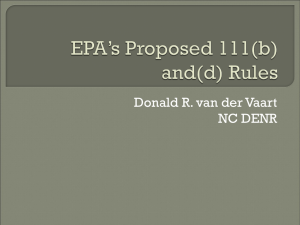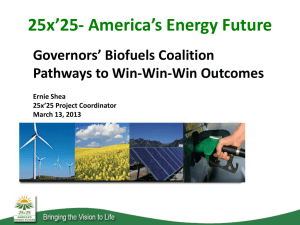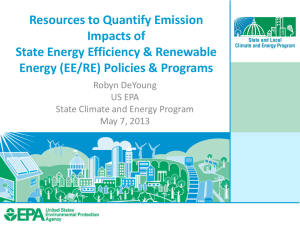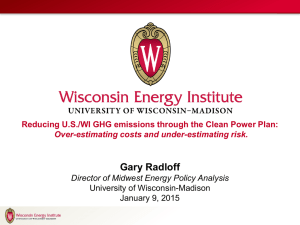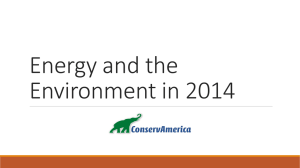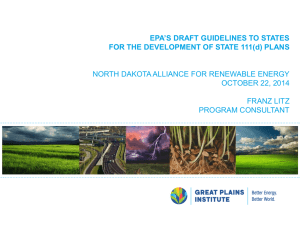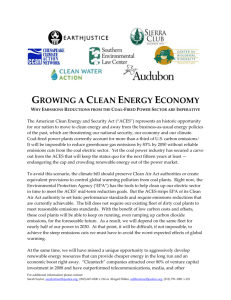EPA GHG Rule for Power Plants
advertisement
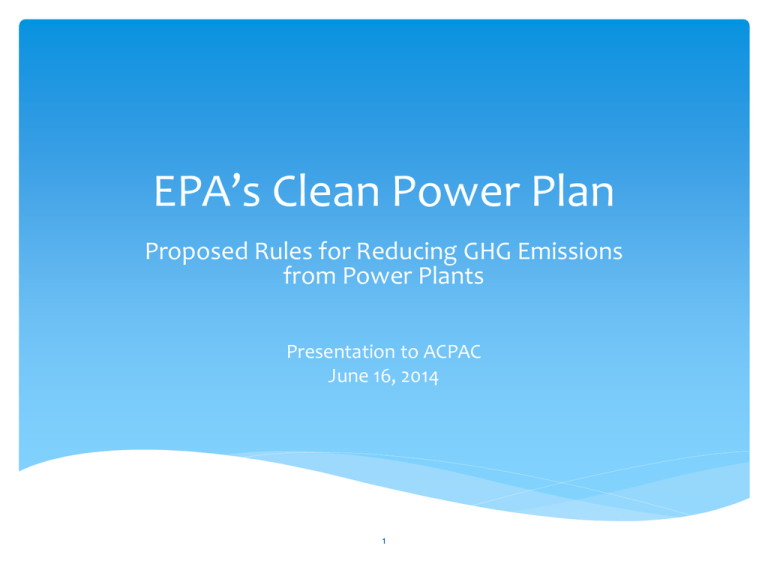
EPA’s Clean Power Plan Proposed Rules for Reducing GHG Emissions from Power Plants Presentation to ACPAC June 16, 2014 1 US Greenhouse Gas Emissions Fossil fuel-fired power plants are the largest source of U.S. GHG emissions Electric power sector responsible for 32% of GHG emissions in 2012 GHG emissions from electricity have increased by about 11% since 1990 2 The Clean Air Act The Clean Air Act (CAA) – 1970 Requires EPA to set standards for different types of air pollution to protect public health and welfare Section 111: establishes a mechanism for setting performance standards for new and existing sources Section 111(b): Gives EPA authority to establish standards for new, modified and reconstructed sources Section 111(d): Gives EPA authority to establish guidelines for state-based programs to achieve reductions from existing sources 3 Regulation of GHGs Under CAA Timeline: 2007: Supreme Court decision Massachusetts v. EPA Affirms EPA authority to regulate GHGs under CAA 2009: EPA Endangerment Finding GHGs endanger public health and welfare 2010: First CAA regulation of GHGs Mobile source tailpipe standards 2012: First EPA proposal to limit GHGs for new power plants 4 GHG Regulations for Power Plants June 2013 – President’s Climate Action Plan Directs EPA to set GHG standards for new and existing power plants Sept 2013 – Proposed CO2 Standards for New Sources 111(b) June 2014 – Proposed CO2 Standards for Existing Sources 111(d) June 2015 – Expected final rules for both new & existing plants June 2016 – State Plans Due for existing power plants Optional Extension to 2017 (single state plan) or 2018 (multi-state plan) 2020-2030 – Implementation and reporting 5 New Source Standards Sets a cap on the rate of emissions Separate limits for new natural gas and coal plants Natural gas: 1,000 lbs/MWh/year Coal: 1,100 lbs/MWh/year OR coal plants can average emissions over 7 years if agree to meet more stringent standard (1,000-1,050 lbs/MWh/year) Requires coal to use carbon capture & sequestration (CCS) Comments were due March 2014, final rule expected in June 2015 6 Existing Source Standards Sets state-specific goals for 2030 Except VT and DC – they have no affected power plants Interim goals starting 2020 Goal = emissions rate (lbs. CO2/MWh) CO2 emissions from a state's power plants ÷ electricity they generate States have the option to convert to a mass goal Goal = EPA determination of emissions reductions each state can reasonably achieve by 2030 using Best System of Emissions Reduction (BSER) EPA has used BSER for other standards under 111(d) 7 Best System of Emissions Reduction Four Building Blocks: Improve efficiency of coal plants Switch to from coal to natural gas, use existing natural gas plants more Increase renewable energy, keep nuclear plants open Increase energy efficiency of electricity consumption – 1.5% per year Goals are based on EPA analysis of BSER opportunities in each state State goals differ A LOT – grid infrastructure, market dynamics and existing policies affect what can be reasonably achieved States do NOT have to implement measures the same way EPA used to calculate the goal 8 Comparison of Proposed State Goals Historic Emissions Rate (2012) Average Interim Goal 2020-29 2030 Emission Rate Goal Required Change North Dakota 1,994 1,817 1,783 11% Maryland 1,870 1,347 1,187 37% Virginia 1,297 884 810 38% Washington 763 264 215 72% Emissions rate = lbs/MWh/year 9 State Plans Must: Identify affected entities Describe the plan approach and geographic scope (single-state or multi-state plan) Identify state emission performance level Demonstrate plan is projected to achieve emission performance goal Identify emissions standards; demonstrate emissions standards are quantifiable, non-duplicative, permanent, verifiable, enforceable Identify monitoring, reporting, recordkeeping requirements Identify milestones and backstop measures Certification of a hearing on the state plan 10 Alternative “less ambitious goals” Proposed Goals Alternative Goals (“Reasonable assumptions” of BSER Implementation) (“Less ambitious assumptions” of BSER Implementation) 6% improvement in coal plant efficiency 4% improvement in coal plant efficiency Increase natural gas plant use to 70% capacity Increase natural gas plant use to 65% capacity 13% renewables by 2030 9.4% renewables by 2025 10.7% cumulative savings by start of 2030 5.2% cumulative savings by start of 2025 11 Environmental Benefits (If implement proposed standards) Reduce carbon pollution from the power sector 30 percent by 2030 (using 2005 baseline) Mitigates 730 million metric tonnes of CO2 Reduce criteria pollutants over 25 percent by 2030, mitigating: 54,000 - 56,000 tons of PM2.5 424,000 - 471,000 tons of sulfur dioxide 407,000 - 428,000 tons of nitrogen dioxide 12 Health Benefits EPA estimates: 2,700 – 6,600 premature deaths prevented 140,000 – 150,000 asthma attacks in children prevented Climate and health benefits worth $55– $93 billion in 2030 13 Things to Watch What will Congress do? What will states & utilities do? What will the courts do? How will compliance be affected by other market and regulatory trends? If there are delays in implementation, what will companies do in the mean-time? 14 Questions & Opportunities for Comment 120 day public comment period States can comment on the proposed % reduction goal Calls and webinars beginning in June 2014 Public Hearings - July 30 at EPA HQ in Washington, DC 15


